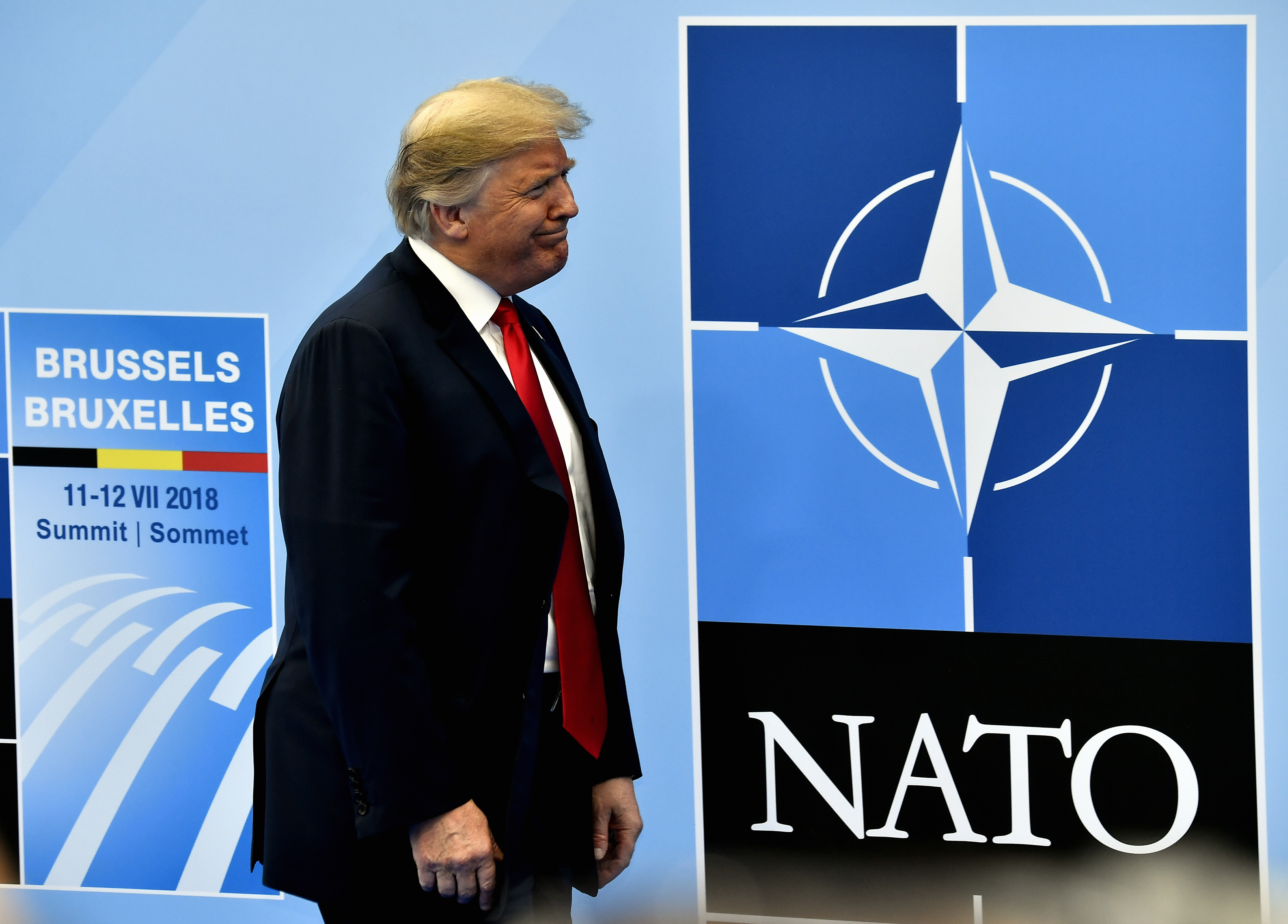
US President Donald Trump arrives for the NATO (North Atlantic Treaty Organization) summit, at the NATO headquarters in Brussels, on July 11, 2018. / AFP PHOTO / POOL / ERIC LALMAND
Tughral Yamin
At the time that the Cold War ended and the Berlin Wall came down, I found myself attending the German Staff Course in Hamburg. Overnight our course material was changed and the enemy forces were no longer based on the Soviet order of battle. The Red Forces were replaced by mythical Pink Forces that we now fought our imaginary battles against on maps and table top exercises. I was quite intrigued because the enemy was no more the Warsaw Pact, so by extension the raison d’etre for North Atlantic Treaty Organization (NATO) no more existed.
I asked my German classmates and teachers, why were the Europeans still continuing with it when the threat was no more? Most replies that I got lacked clarity and conviction. I was told there were still common enemies like Saddam Hussain. A megalomaniac dictator with ambitions to make nuclear bombs that could be used against Israel. These allegations would ultimately prove false but would destroy Iraq in the process. The actual reason to defeat Saddam Hussain was to occupy his oilfields – the largest in the world. True to the predictions by my German friend, the first Gulf War was fought in 1991 to ‘liberate’ tiny Kuwait from Iraq.
Thereafter the nature of warfare changed. On September 11, 2001, members of a shadowy organization called Al Qaeda struck on mainland United States and destroyed the Twin Towers in Manhattan and hit the building of the Pentagon in Washington DC. The age of terror had arrived in all its forms and manifestations. The US launched a counter offensive against the Taliban government in Afghanistan that had provided refuge to Al Qaeda’s leadership. The mission to destroy Al Qaeda became the Global War against Terrorism. Along the way the Americans found it convenient to strike against Iraq once again to complete the unfinished business of dismantling the Baathist government and hang Saddam Hussain. Meanwhile in Afghanistan, an International Stabilization Force (ISAF) led by the US tried to steady the war wracked country. The ISAF was predominantly NATO. Seventeen years on, the war has not ended in Afghanistan and there are increasing signs of frustration because the resurgent Taliban continue to operate with impunity and control large swathes of territory. Another addition to this explosive cocktail is the presence of the local franchise of Islamic State (IS) in Afghanistan or Khorasan.
While American diplomats and generals and the government in Kabul are thinking of actually talking directly with the Taliban, there are also signs that the NATO alliance is completing its life cycle. President Donald Trump has increasingly shown his annoyance with his European partners. The Meeting of the Group of 7 wealthy nations in Canada showed cracks. The iconic picture of the German Chancellor Angela Merkel leaning down and glowering at a pouting Putin sitting down in a chair as an unhappy child was a picture worth a thousand words. To add insult to injury, before leaving Quebec, Trump met his Canadian host Trudeau and used harsh words to berate him. The pressure was ratcheted up in the Brussels NATO conference, when Trump ordered his European allies to share a larger burden of defense. He wanted them to not just increase their defense spending but do it from 2 percent of their GDP to an unprecedented 4. In Britain he blasted the British Prime Minister, Theresa May for her pro-European policy after Brexit and praised her former colleague Boris Johnson for ditching her. There was more to come. Trump next went to Helsinki to meet the Russian President. There was a general expectation that Trump with his brash attitude would stand up to Putin and blame him for interference in the 2016 US election. No such thing happened and on his return Trump had to do a lot of explaining to his home audience.

While Trump was seen as cozying up to the Russians he had declared a trade war not only against China but also against the Europeans and the Canadians. All this seems to have made the American foreign policy murky. The nuclear deal with Iran has been trashed and a new relationship has started with North Korea’s Kim. The US Embassy has opened up in Jerusalem and in the Arab world the Saudis are firmly in his pocket. The world is changing at an alarming pace.
Although NATO is not yet dying a premature death but if it does there will be a range of new alliances. The Russian, Chinese, Iranian and Pakistani intelligence chiefs have recently met to discuss the issue of the IS in Afghanistan. It was reported in the press in April this year that Shanghai Cooperation Organization (SCO) would hold battle drills in the Urals in which Indian and Pakistani Special Forces would operate together.
In the changing environment a number of questions come to mind. If NATO goes, would the Europeans make a defense alliance of their own? Britain and France have nuclear weapons but rest everyone else is dependent on the extended deterrence provided by the US. The Americans have bases in Germany, Japan and Korea. Would the US be decreasing its military footprint around the world? Would it be accepting the Russians as equal partners despite the annexation of Crimea? These are questions that should be agitating the minds of military and defense analysts the world over. New combinations and permutations need to be studied and implications for the region must be considered.
Dr. Tughral Yamin is Associate Dean, Center for International Peace and Stability, National University of Science & Technology, Islamabad.




